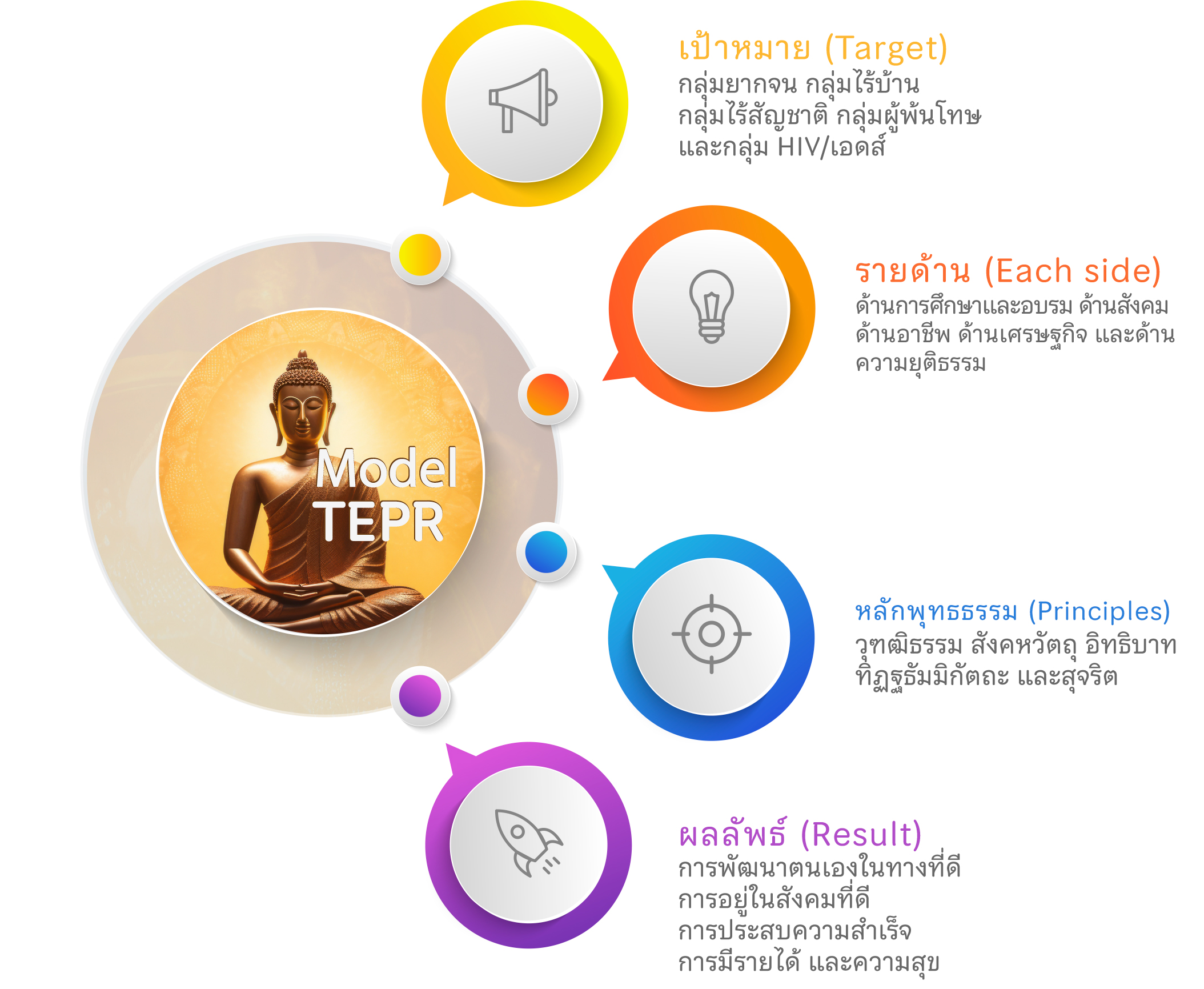Integrating Buddhist Principles with The Development of The Underprivileged Person in Khon Kaen Province
Main Article Content
Abstract
The purposes of this research were: 1) to study theoretical concepts regarding the development of the underprivileged, 2) to study Buddhist principles related to the development of the underprivileged 3) to integrate Buddhist principles in the development of the underprivileged. Opportunities 4) to present guidelines and knowledge about
integrating Buddhist principles with the development of the underprivileged in Khon Kaen province by studying from the Tripitaka relevant research documents and in-depth
interviews analyze content and present it accordingly.
The results revealed that:
1. Buddhist principles related to the development of the underprivileged in Khon Kaen Province include Vuddhi Dhamma 4, Sangkhahavatthu 4, Titthadhammikattha 4, Iddhipada 4 and Sujarit 3.
2. Concepts and theories regarding the development of the underprivileged are 1) education and training 2) promoting participation in social activities 3) promoting jobs and careers 4) opening economic opportunities 5) promoting freedom and justice.
3. Integrate the principles of Buddhism as follows: Vuddhi Dhamma 4 to develop education and training, Sangha Vatthu 4 to promote participation in social activities.
Iddhipada 4 to develop the promotion of work and careers, Titthadhammikattha 4 to promote the economy and honesty, 3 to promote the aspect of freedom and justice.
4. A new body of knowledge was born called Model TEPR, consisting of 5 groups of Targets, separated into 5 Each Side, 5 Principles, and 5 Result.
Article Details

This work is licensed under a Creative Commons Attribution-NonCommercial-NoDerivatives 4.0 International License.
เพื่อให้เป็นไปตามกฎหมายลิขสิทธิ์ ผู้นิพนธ์ทุกท่านต้องลงลายมือชื่อในแบบฟอร์มใบมอบลิขสิทธิ์บทความ ให้แก่วารสารฯ พร้อมกับบทความต้นฉบับที่ได้แก้ไขครั้งสุดท้าย นอกจากนี้ ผู้นิพนธ์ทุกท่านต้องยืนยันว่าบทความ ต้นฉบับที่ส่งมาตีพิมพ์นั้น ได้ส่งมาตีพิมพ์เฉพาะในวารสาร วิชาการธรรม ทรรศน์ เพียงแห่งเดียวเท่านั้น หากมีการใช้ ภาพหรือตารางของผู้นิพนธ์อื่นที่ปรากฏในสิ่งตีพิมพ์อื่นมาแล้ว ผู้นิพนธ์ต้องขออนุญาตเจ้าของลิขสิทธิ์ก่อน พร้อมทั้ง แสดงหนังสือที่ได้รับการยินยอมต่อบรรณาธิการ ก่อนที่บทความจะได้รับการตีพิมพ์References
กรรณิกา กุกุดเรือ. (2563). การพัฒนาระบบภาคีเครือข่ายอาชีพสำหรับเด็กและเยาวชน ของศูนย์ฝึกและอบรมเด็กและเยาวชน. วารสารวิชาการอาชญาวิทยาและนิติวิทยาศาสตร์ โรงเรียนนายร้อยตำรวจ, 6(1), 120-132. https://so02.tci-thaijo.org/index.php/forensic/article/view/239737/164757
ฐานเศรษฐกิจดิจิทัล. (2565). เปิดสถิติ “คนจน” ปี 2565 จังหวัดไหนพัฒนาดีสุด-แย่ลง. เข้าถึงได้จาก https://www.thansettakij.com/economy/514306
ปกรณ์กิตติ์ ม่วงประสิทธิ์ และศิริณา จิตต์จรัส. (2560). การจัดการศึกษาสำหรับเด็กด้อยโอกาส. วารสารศึกษาศาสตร์ มหาวิทยาลัยศิลปากร, 15(2), 74-91. https://so02.tci-thaijo.org/index.php/suedujournal/article/view/174915/125188
ผดุงเกียรติ์ แจ่มแจ้ง, ธัชชนันท์ อิศรเดช และประณต นันทิยะกูล. (2567). การมีส่วนร่วมทางการเมืองของประชาชนตามหลักสุจริต 3 ในตำบลมาบตาพุด อำเภอเมือง จังหวัดระยอง. วารสารสหวิทยาการนวัตกรรมปริทรรศน์, 7(6), 92-106. https://so04.tci-thaijo.org/index.php/jidir/article/view/274864/185660
พระครูธรรมบาลพิจิตร ธมฺมวิจิตฺโต (ยอยอด). (2560). หลักพุทธธรรมที่ใช้ในการพัฒนาชุมชนเข้มแข็งของจังหวัดศรีสะเกษ. วารสาร มจร อุบลปริทรรศน์, 5(1), 194-204.
พระราชวรมุนี (ประยุทธ์ ปยุตฺโต). (2563). พระพุทธศาสนากับสังคมไทยปัจจุบัน. กรุงเทพฯ: เคล็ดไทย.
มหาจุฬาลงกรณราชวิทยาลัย. (2539). พระไตรปิฎกภาษาไทย ฉบับมหาจุฬาลงกรณราชวิทยาลัย ชุด 45 เล่ม. กรุงเทพฯ: มหาจุฬาลงกรณราชวิทยาลัย.
วัชราภรณ์ จันทนุกูล และสัญญา เคณาภูมิ. (2559). แนวทางการจัดสวัสดิการสังคมระดับชุมชนอย่างยั่งยืน. วารสารวิจัยกับการพัฒนาเชิงพื้นที่, 8(4), 3-14. https://so01.tci-thaijo.org/index.php/abcjournal/article/view/95492/74593
สำนักงานสภาพัฒนาการเศรษฐกิจและสังคมแห่งชาติ. (2565). รายงานการประชุมคณะกรรมการเพื่อการพัฒนาที่ยั่งยืน ครั้งที่ 1/2565. เข้าถึงได้จาก https://sdgs.nesdc.go.th/wp-content/uploads/2023/02/20230202_รายงานการประชุม-กพย.-ครั้งที่-1-2565.pdf
